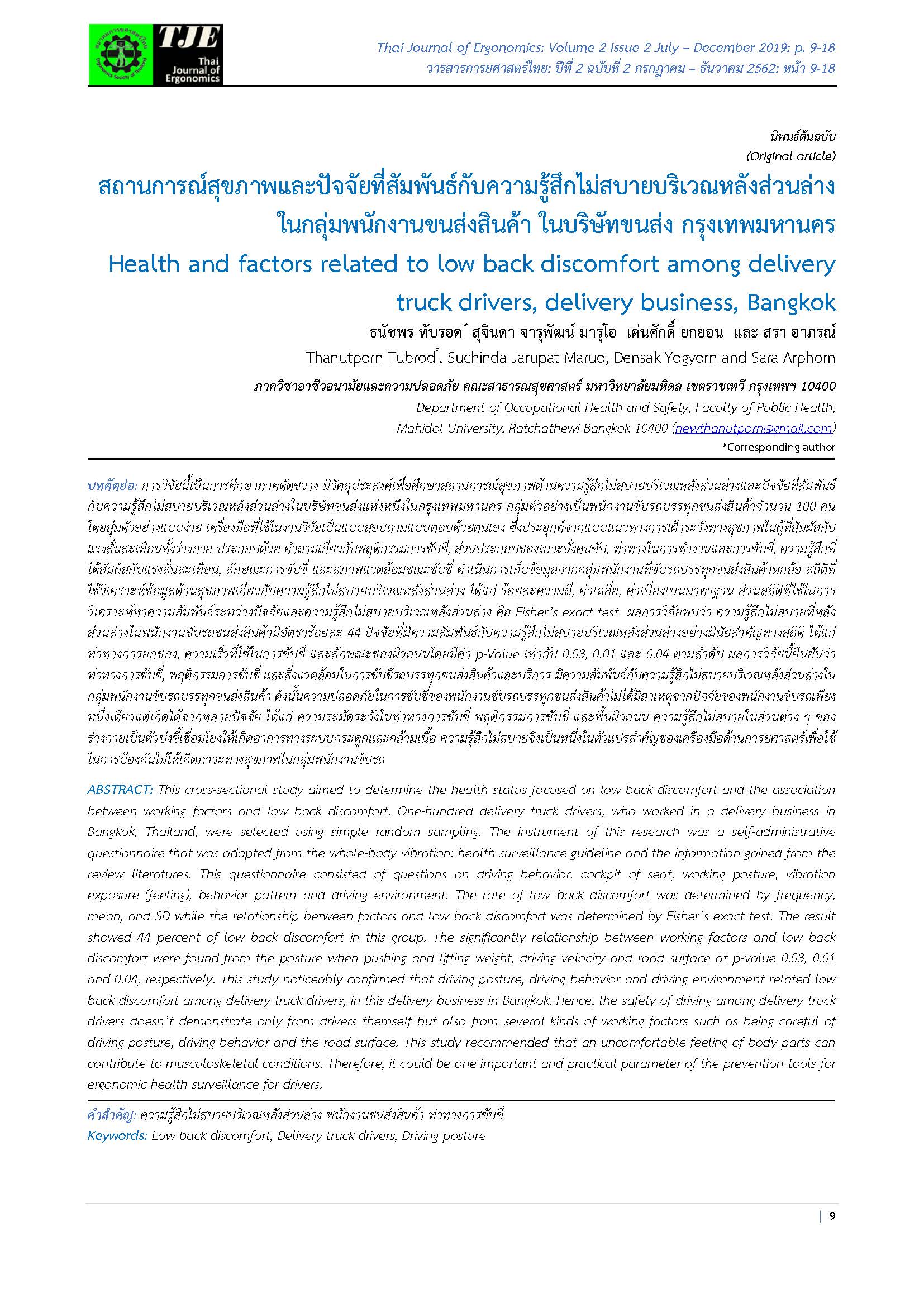Health and factors related to low back discomfort among delivery truck drivers, delivery business, Bangkok
Main Article Content
Abstract
This cross-sectional study aimed to determine the health status focused on low back discomfort and the association between working factors and low back discomfort. One-hundred delivery truck drivers, who worked in a delivery business in Bangkok, Thailand, were selected using simple random sampling. The instrument of this research was a self-administrative questionnaire that was adapted from the whole-body vibration: health surveillance guideline and the information gained from the review literatures. This questionnaire consisted of questions on driving behavior, cockpit of seat, working posture, vibration exposure (feeling), behavior pattern and driving environment. The rate of low back discomfort was determined by frequency, mean, and SD while the relationship between factors and low back discomfort was determined by Fisher’s exact test. The result showed 44 percent of low back discomfort in this group. The significantly relationship between working factors and low back discomfort were found from the posture when pushing and lifting weight, driving velocity and road surface at p-value 0.03, 0.01 and 0.04, respectively. This study noticeably confirmed that driving posture, driving behavior and driving environment related low back discomfort among delivery truck drivers, in this delivery business in Bangkok. Hence, the safety of driving among delivery truck drivers doesn’t demonstrate only from drivers themself but also from several kinds of working factors such as being careful of driving posture, driving behavior and the road surface. This study recommended that an uncomfortable feeling of body parts can contribute to musculoskeletal conditions. Therefore, it could be one important and practical parameter of the prevention tools for ergonomic health surveillance for drivers.
Article Details

This work is licensed under a Creative Commons Attribution-NonCommercial-NoDerivatives 4.0 International License.
References
Thailand Post Co. Ltd. Annual Report 2016 Thailand Post Co., Ltd.: Stepping forward to the 14th year; 2016.
Abledu JK, Offei EB, Abledu GK. Predictors of work-related musculoskeletal disorders among commercial minibus drivers in accra metropolis, Ghana. Advances in Epidemiology 2014; https://doi.org/10.1155/2014/384279.
Fadhli MZK HN, Khairul NMI, Kaswandi MA, Junaidah Z. Ergonomic risk factors and prevalence of low back pain among bus drivers. Austin J Musculoskelet Disord 2016;3(1):1028.
อรรถพล แก้วนวล กลางเดือน โพชนา. ความชุกของความผิดปกติของระบบกล้ามเนื้อและกระดูกโครงร่างที่เกี่ยวเนื่องจากการทำงานในอาชีพต่างๆ. วารสารสาธารณสุขมหาวิทยาลัยบูรพา 2560;12(2):54-64.
Hege A, Perko M, Johnson A, Yu CH, Sönmez S, Apostolopoulos Y. Surveying the impact of work hours and schedules on commercial motor vehicle driver sleep. Saf Health Work 2015;6(2):104-13.
นภาพร รักบ้านเกิด. การศึกษาและเปรียบเทียบภาวะปวดหลังบริเวณกระเบนเหน็บในกลุ่มอาชีพพนักงานผู้ให้บริการ; 2548.
กุณฑลีย์ บังคะดานรา สรา อาภรณ์ อรวรรณ แก้วบุญชู ณัฐกมล ชาญสาธิตพร. ความสัมพันธ์ระหว่างปัจจัยส่วนบุคคลกับความสามารถในการทำงานของพนักงานขับรถบรรทุกสารเคมี. วารสารพยาบาลศาสตร์และสุขภาพ 2555;35(2): 62-71.
ณัชยา แซ่เจิ้น. ความชุกและปัจจัยพื้นฐานส่วนบุคคลที่มีผลต่ออาการผิดปกติของระบบโครงร่างและกล้ามเนื้อของพนักงานขับรถตู้โดยสารประจำทาง: กรณีศึกษา สถานีขนส่งอำเภอหาดใหญ่ จังหวัดสงขลา. วารสารวิจัยมข. 2557;19(1):107-18.
Phatrabuddha N, Yingratanasuk T, Rotwannasin P, Jaidee W, Krajaiklang N. Assessment of sleep deprivation and fatigue among chemical transportation drivers in Chonburi, Thailand. Saf Health Work 2018;9(2):159-163.
Robert V, Krejcie D. Determining sample size for research activities educational and psychological measurement. Educ Psychol Meas 1970;30:607-10.
Pope M, Magnusson M, Lundström R, Hulshof C, Verbeek J, Bovenzi M. Guidelines for whole-body vibration health surveillance. J Sound Vib 2002;253(1):131-67.
สถานะสุขภาพ. 2552 รายงานการสำรวจสุขภาพประชาชนไทยโดยการตรวจร่างกาย ครั้งที่ 4. สืบค้นจาก https://www.hiso.or.th/hiso/picture/reportHealth/report/report1_6.pdf
Corlett EN, Bishop RP. A Technique for assessing postural discomfort. Ergonomics 1976;19(2):175-82.
Kuorinka I, Jonsson B, Kilbom A, Vinterberg H, Biering-Sorensen F, Andersson G, et al. Standardised Nordic questionnaires for the analysis of musculoskeletal symptoms. Appl Ergon. 1987;18(3):233-7.
Gliem JA, Gliem GR. Calculating, interpreting, and reporting Cronbach's alpha reliability coefficient for Likert-type scales; 2003.
Feise RJ, Michael Menke J. Functional rating index: a new valid and reliable instrument to measure the magnitude of clinical change in spinal conditions. Spine 2001;26(1):78-86.
Dimitriou M. Human muscle spindle sensitivity reflects the balance of activity between antagonistic muscles. J Neurosci 2014;34(41):13644-55.
Kennedy J, Oakley C, Summon S, Parry I, Wilkinson E, Brown J. Impact of road humps on vehicles and their occupants. TRL614. 2004: 48.
Smith J, Mansfield N, Gyi D. Long-term discomfort evaluation: comparison of reported discomfort between a concept elevated driving posture and a conventional driving posture. Procedia Manuf 2015;3:2387-94.
Majid NA, Abdullah MFE, Jamaludin MS, Notomi M, Rasmussen J. Musculoskeletal analysis of driving fatigue: The Influence of seat adjustments. Adv Eng Forum 2013;10:373-78.


